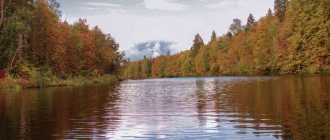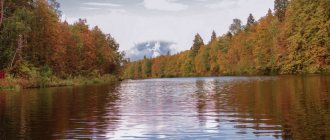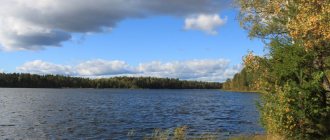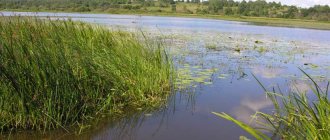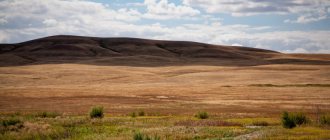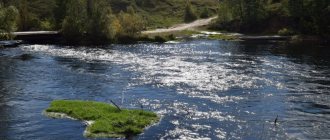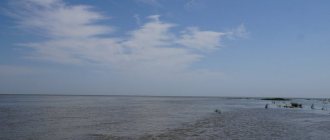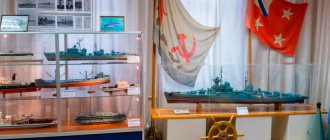Voronezh is not the first thing that comes to mind when we think about where to spend our holidays. Nevertheless, its surroundings represent a rather unique area for central Russia. Here, many cave temples are concentrated in a compact area, the surface of the earth is cut by winding canyons and snow-white chalk quarries, and in the south of the region there is even its own desert. The region is not deprived of objects of historical and cultural heritage.
In the Voronezh region, you can spend an active weekend or go here for a whole week to immerse yourself in exploring the local beauties, either with a tent or staying in one of the hotels in the capital of the region.
Much of the local attractions are outdoors, making it an ideal family outing. After all, among forests, fields and caves, children are never bored, and besides, you can touch everything with your own hands. And parents don’t need to worry that a noisy family will disturb those around them - there is enough space for everyone.
Wildlife sanctuaries and reserves of the Voronezh region
The nature and landscape of the Voronezh region are so unique that you want to preserve every part for future generations. Therefore, nature reserves occupy one of the most significant places in the development of the region.
Voronezh Biosphere Reserve
- Coordinates on the map: 51.942180, 39.597760.
At the beginning of the 20th century, it was believed that almost the entire beaver population in Russia had already been exterminated, until a group of scientists discovered several settlements on the Usmanka River. They turned to the People's Commissariat of Agriculture of the RSFSR with a request to create a reserve in these places in order to preserve this valuable game animal, and the request was granted.
In 1932, an order was signed to create the world's first experimental beaver reserve, and two years later scientists received the first offspring.
Little beaver cubs were settled all over the world. Descendants of the same animals discovered at the beginning of the century live today even in Lapland. In the reserve, the beavers have a real town, equipped with the latest technology, and the Beaver News newspaper is published. The animals also welcome guests with pleasure.
Divnogorye
- Address: Divny lane, 25, Divnogorie village.
Here, on an area of more than 17 hectares, many relict plants and animals have been preserved, many of which are listed in the Red Book of Russia. In addition, the reserve also has the status of an archaeological museum and a natural monument of federal significance.
Its main attractions date back to different eras, but the most common are monuments from the Bronze Age, the Middle Ages and the Paleolithic.
The main decoration of the reserve is the church, which is located inside the chalk mountain. It was hollowed out at the beginning of the 19th century by monks and consecrated in honor of the Sicilian Icon of the Mother of God.
Lomovsky Landscape Park
- GPS coordinates: 50.759986, 41.175112.
Loma Farm, one of the most interesting places for lovers of ethnotourism, is located almost on the border with the Volgograd region. It constantly hosts various kinds of festivals, and there is entertainment not only for adults, but also for children.
No one will be bored. You can swing on a wooden swing in the so-called Dead Forest, visit a stone labyrinth or a sauna. And then drink herbal tea from 10 types of medicinal plants growing right in the park. Many of them are relicts, preserved from ancient times.
Many species of wild animals and birds have found shelter here. The pond is inhabited by fish, and on the shore there is a completely restored water mill, giving the attraction an old Russian flavor.
Khopersky Reserve
- Coordinates: 51.234150, 41.736416.
It was created to preserve the muskrat population living in the Khoper River valley in 1935. But the main asset of the reserve is its rich flora. More than 80% of its area is covered with a variety of flora, of which there are about 1,200 species.
Some relict plants have also been preserved here, for example, water chestnut - chilim. Many animals and birds living in the reserve are rare and are listed in the Red Book.
Zoo nursery Chervleny Yar
- Address: Smorodinovaya st., 2D, Voronezh.
This zoo complex is a branch of the Voronezh Zoo, but is located in a forest belt, on the shore of the Voronezh Reservoir. Most of its inhabitants are ungulate mammals, such as roe deer, deer, yaks, and bison.
But there are even wild boars, guinea fowl, and mouflons. For visitors, eco-trails have been developed here, passing in the shade of man-made plantings, and a rock garden, where you can not only experience Zen, but also admire various rock formations.
Stone steppe
- Coordinates: 51.036038, 40.735479.
This unique reserve is of great importance not only for the Voronezh region, but also for the whole world. After all, studies of human economic activity on the soil layer have been conducted on its territory for more than a hundred years.
The main attractions of the reserve are:
- centuries-old deposits of arable, but left unsown lands,
- Dokuchaevskoye Reservoir, most often called the sea,
- the first forest belts laid out in the 19th century;
- unique landscape and fauna, where marmots are the main ones.
Don't miss: Where to go with a child in Voronezh
Reason five – sports
Already in 1875, a yacht club appeared in Voronezh, which became the main center of sports in the city. A cyclists' society, an athletic and chess club, and a wrestling club worked under him. The yacht club held speed skating, figure skating and athletics competitions. Future Olympic champion Nikolai Panin-Kolomenkin began training there.
Anatoly Protopopov was born in the Pavlovsky district of the Voronezh region, who in 1948, at the USSR weight-lifting championship among sailors, lifted a two-pound weight with one hand 1002 times. This record has not been repeated by anyone in the 20th century.
Among the natives of the Voronezh region are successful modern athletes: diver Dmitry Sautin, track and field athlete Yuri Dumchev, gymnasts Nikolai Kryukov, Tatyana Tuzhikova, Angelina Yushkova, Angelina Melnikova, Victoria Komova. In 2013, Voronezh rock climber Evgenia Malamid entered the top three strongest in the world.
Open air museums
Not every region has museums of this kind. But for the Voronezh region this is the norm.
Kostenki
- Address: st. Kirova, 6A, Kostenki village.
The archaeological monument-museum near Voronezh is known throughout the world. Early Paleolithic finds were discovered here, refuting the entire generally accepted theory of the origin of Homo sapiens. For the entire period of excavations on an area of 10 square meters. km, more than 60 ancient sites were discovered, the age of which is 15-45 thousand years.
The complex is open to the public. Tourists are invited to get acquainted with the appearance of our ancestors, which was recreated using sculptural modeling from skulls, to see a human dwelling built from mammoth bones, as well as unique collections of weapons and household items of the Stone Age.
Village
- Address: Slavyanskaya st., 37A, Ertil.
The Derevenka Ethnomuseum is located in the Ertil region. Its creator is the ataman from Ertil V.I. Brezhnev. His idea was not just a museum, but an entire museum village, each building in which is a separate exhibition. All exhibits were lovingly collected or made by the creator and his wife.
Most of them are dedicated to peasant life of the 14th-19th centuries. Here you can see a real peasant hut, a pottery workshop, a room where weavers worked and spun yarn, a Russian stove and a hayloft. It is important that you can not only see all this, but even try yourself in some craft.
Lev Tolstoy village
An interesting village in the Lipetsk region with many attractions. You can see water towers, a funny monument to a steam locomotive, and the more than century-old Trinity Church, which houses a museum of Orthodoxy. And don’t forget to check out the Memorial Museum in memory of L.N. Tolstoy "Astapovo". It is located in the house of the head of the Astapovo station, I. I. Ozolin, where, after being ill for seven days, Tolstoy died on November 7, 1910. Later in 1918, the Astapovo station was renamed Lev Tolstoy. Memorial Museum in Memory of L.N. Tolstoy "Astapovo" is open from Tue to Sun from 10.00 to 17.00. Ticket 60 rub. Museum address: Lev Tolstoy village, st. Privokzalnaya, 12.
Stud farms in the Voronezh region
Horses are the special pride of the region. In Tsarist Russia, their fame resounded throughout the country and beyond, but only a few farms became the owners of purebred trotters. Today their doors are open to visitors.
Khrenovsky
- Address: Bobrovsky district, Sloboda village.
The history of the factory began in 1776. It was here that the two most famous breeds of horses were bred - the Oryol Trotter and the Saddlebred. After the revolution, the breeding farm was nationalized, and in 1950 a storage museum was created on its territory. It stores documents, awards and stud books from the very first days of its foundation.
Nowadays, they not only breed horses here, but also conduct excursions for tourists, who are offered to get acquainted with the history of breeding and the unique architecture of the ancient building. Naturally, here you can see the handsome trotters with your own eyes.
Chesmensky
- Address: Bobrovsky district, Chesmenka village.
Another breeding farm founded by Count Orlov is located in the village of Chesmenka. Today, its main focus is not only breeding trotters, but also cattle, as well as crop production. At the plant's hippodrome, horse racing is often held in honor of Russian national holidays, and there is also a riding school.
Sights of the village of Rudni
- Local history museum;
- House-Museum of M. A. Egorov , who planted the USSR flag over the captured Reichstag building in Berlin;
- the Katyusha memorial on the outskirts of the village;
- Memorial "Grieving Mother" at the burial site of those killed in the Second World War.
Memorial "Katyusha"
Beautiful lakes in the Voronezh region
Strange lakes, of which there are many on the map of the Voronezh region, are more the norm than the exception to the rule. Mysterious and interesting, they are considered one of the most visited places.
Turtle Lake
- Coordinates: 51.820053, 39.410780.
Not far from the village of Maklok there is another unique natural monument of the Voronezh region. The only body of water where the marsh turtle lives - a very rare, endangered animal. The banks of the reservoir are unusually picturesque. They are covered with trees and bushes.
The lake is quite deep, and on one side it generally turns into a swamp. The vegetation on the other side is denser and creates deep shade. It’s quite easy to see turtles here; they are found at every step and are the main object that attracts tourists here.
Chalk Lake
- Coordinates on the map: 51.649818, 38.990737.
Another reservoir attractive to travelers is located in the Semiluksky district, not far from the village of Orlov Log. Locals call it the Cretaceous Sea, although the body of water itself is small. The place is quite lively.
There are always vacationers on the shore who come to swim, sunbathe or play beach volleyball on the sandy shore. The bottom of the lake, by the way, is also chalk pleasant to the touch, but only at the beginning. The further you move from the shore, the more silt you will feel with your feet. The water here is fresh and muddy, due to chalky impurities, but it holds almost like sea salt water.
Blue Lake in Otrozhka
- Coordinates: 51.726205, 39.288681.
There is a lake in the Voronezh region, the appearance of which is very unusual for this region. It is filled with warm water of an amazing turquoise hue. The lake is man-made - water filled an abandoned sand quarry and now this place is very popular among local residents and vacationers. The smooth sandy beaches around it attract even more people who want to swim, and rumors that there is a dump of industrial waste at the bottom of the reservoir do not stop anyone.
Indian Lake
- Coordinates: 51.336287, 41.052658.
The freshwater body of water in the Anninsky district has an almost perfect round shape. And it didn’t get this name because of women. This is due to pelicans, which were previously popularly called the woman bird.
These birds, completely unusual for the region, constantly flew in and nested on the banks of the reservoir. However, for more than 150 years nothing has been heard about them in these parts, but they did not change the name.
The water here is always clean, and the depth reaches 5 meters. Fans of camping and fishing will definitely like this place, because the shores of the lake are always quiet and peaceful. The reservoir has the status of a Natural Monument of regional significance.
The first reason is scientific.
The names of famous scientists and inventors are associated with the region. Thanks to the traveler and zoologist Nikolai Severtsov, who was born in Bobrovsky district in 1827, traces of ancient glaciers, oil outcrops, deposits of coal, granite, jasper were found in different places on the planet, and gold mines were discovered. A peak in the Pamir-Alai mountain system and a glacier in the Pamirs were named in honor of Severtsov. Peasant Daniil Bokarev from Alekseevskaya Sloboda, Voronezh province, invented a method for extracting oil from sunflowers, and former naval lieutenant Fyodor Kolyvanov created the prototype of a modern bathyscaphe. In addition, natives of the Voronezh region invented hot rollers, one of the first versions of a can opener, a device for safely removing ticks, and a laser. Read more about these and other inventions here.
The most interesting caves of the Voronezh region
Most of the caves in the Voronezh region are man-made. Most often they were created by monks and hermits for the purpose of founding monasteries or individual cells. Nowadays, they are given the status of historical and natural monuments and everything possible is done to preserve this heritage for future generations.
Cave Ear
- Coordinates: 50.986657, 39.330957.
The cave got its unusual name because of the shape of the entrance, which resembles a human ear. It is located in the Liskinsky district, not far from the village of Selyavnoye. Today it is considered one of the most inaccessible caves in the Voronezh region, and it is impossible to get into it without special climbing equipment. In addition, there are only two entrances to it, which, moreover, are located in hard-to-reach places.
The cave was created by local men - Nikifor Shatov and Pyotr Kubanov. According to their plan, there should have been a cave temple in it.
They made arched ceilings in the rooms, and even painted an image of a bell tower on the wall in one of the branches, but things didn’t go further than that. Nowadays it has been little studied, but it attracts not only speleologists. Despite the inaccessibility, vandal art can be seen here. The walls of the cave, especially at the entrance, are covered with inscriptions.
Cave Casemate
- Coordinates: 50.987815, 39.332409.
It is located on the right bank of the Don, in the Liskinsky district, not far from the Ukho cave. Most likely, it housed an observation post or some kind of defensive structure, which is why the cave got its name.
Its purpose is also indicated by a small window cut into the wall. It offers an overview of the Don and part of the coast. The dimensions of the cave are small, the length is only 10 m. There are small narrow corridors running to the sides from the main room.
St. Andrew's Cave
- GPS coordinates: 50.086565, 40.152660.
It is often called Gorokhovskaya, after the name of the village next to which it is located. The age of the cave is approaching two centuries; according to official sources, its development began in 1859. However, research shows that it may be much older. This is also evidenced by the drawings of ships found on the columns. The style of these images dates back to the 17th century and, if this is actually the case, it may well be considered one of the most ancient in the Voronezh region.
The cave is a temple with high ceilings and vaults. In some places the height reaches 5 meters. The church itself is located in the center, and corridors run in different directions from it. By the beginning of the 20th century, most of them were destroyed, but 20 years ago they began to be restored. Despite this, the cave continues to deteriorate, which is greatly facilitated by vandals, and if its restoration is stopped, it may disappear from the face of the earth.
Shatrishche Cave
- Coordinates: 50.968984, 39.426284.
This cave is located in the cavity of a chalk mountain and is a man-made tunnel. Initially, its length reached one kilometer, but after the collapse it was reduced by three times. The tunnel is more than 400 years old; it was dug by monks from the Spaso-Preobrazhensky Monastery.
After the revolution, it began to attract looters, then chalk mining was established in it, which is why the cave began to collapse. Today, only one cell remains intact, located right at the entrance, and its permanent inhabitants are bats. But, nevertheless, the cave is of great historical value.
Kalacheevskaya Cave
- Coordinates: 50.415965, 41.005513.
It belongs to the historical and natural monuments of the 17th-18th centuries and is noticeably different from most cave temples. Including the fact that the relics were placed on special stone beds, and not in niches, as was customary at that time.
The cave is located in the upper part of Mount Penkovaya, on the left bank of the Tolucheevka River. The entrance to it is located at an altitude of 120 m, and the cave itself is considered the longest in the region. The total length of all its corridors is about 1000 m. The rooms in it are located on two levels. The upper floor can be reached via a spiral staircase.
The uniqueness of the cave attraction lies in the unusual embossed patterns reminiscent of graffiti. They can be seen on the walls of corridors and in some rooms. The cells are not of particular interest, except for one, called the Red Room.
The walls and ceiling were completely painted with ocher, and blue snowflakes swirled across the red background. Today the cave is in a neglected state. This is due to a collapse that occurred in 2006. Stones and fragments of rock still lie at its entrance.
Reason seven - shipbuilding
Peter the Great chose Voronezh as a springboard for the construction of a navy and the capture of the Turkish fortress of Azov. Voronezh craftsmen at that time had 100 years of experience in building river vessels, and the navigable Voronezh River flowed into the Don, which gave access to Azov. The king personally participated in the construction work. The first battleship "Goto Predestination" was created in Voronezh. Now on Admiralty Square there is a smaller copy of it - a museum ship of the same name.
Popular mountains and tracts of the region
Unusual mountain peaks created by such a seemingly short-lived rock as chalk. But no, they have been standing in their place for many centuries, hiding the secrets of history.
Krivoborye tract
- Address: Krivoborye village.
The geological natural monument in the Ramonsky district has had this status since 1969. This is a picturesque place on the banks of the Don River. The winding right bank is a steep sandy cliff, while the left bank is flat, densely overgrown with bushes. The height of the coast in some places reaches 50 m. It is always quiet and calm here, so the tract is popular among tourists and fishermen.
Quarry White Well
- Coordinates: 51.622222, 38.968611.
This name is given to the chalk canyon, which remained after chalk mining. Today it is not abandoned, but on the contrary is a huge success among rock climbers and motorsports enthusiasts. The huge size of the canyon made it possible to build highways in it, where various competitions are held annually.
And even fishermen can spend time here doing their favorite pastime - in the quarry there is a wonderful chalk lake with all the inhabitants that belong to it. And on the banks of the reservoir there are several courts for beach volleyball, so you can gather a team and organize competitions in this sport.
Bald Mountain
- Coordinates: 51.733574, 39.224057.
This name, however, which has nothing to do with witches’ Sabbaths, is the name of a natural and archeological monument on the shore of the Voronezh Reservoir. At its top there are two amazing trees: a huge oak tree, more than 400 years old, and a linden tree, inside of which there is a cave. The age of the linden tree is not known for certain, but it is considered very ancient.
In general, in the vicinity of Lysogorye there are surprisingly many old trees, and on the mountain itself there are unique Slavic burial grounds, presumably of the Borshev culture, dating back to the 9th century. There are about thirteen of them in total. Unfortunately, the top of the mountain is getting closer and closer to the reservoir every year, threatening to fill up the burial grounds.
Chalk Mountains
- Coordinates on the map: 51.116876, 39.206057.
Hills of this type are not uncommon in the Voronezh region, but it is from here that a wonderful view of the surrounding area and the valley of the great Don opens up. To see them, you need to go to the village of Uryv-Pokrovka.
They are quite popular among tourists, because you can only observe such a truly pristine landscape here. These places are especially crowded in the summer, when you can see from above the fields with ears of corn, the quiet calm flow of the river and flowering meadows on its banks.
Mordva tract
- Coordinates: 51.027840, 39.040555.
The small, only 0.5 hectares, area on the banks of the Potudan River is truly unique. After all, here you can see the remains of the chalk forest. It turns out that conifers grow well on chalk deposits without needing soil.
Today, of the ancient plants, only one pine tree has survived here. Its age probably does not exceed a hundred years, and its height is about 14 m. However, after a few centuries, chalk pines will again rise in this place and the next generations will admire their desire for life.
Reason six - literary
The Voronezh region is the birthplace of outstanding poets and writers: Ivan Bunin, Andrei Platonov, Samuil Marshak, Ivan Nikitin, Alexei Koltsov, Grigory Baklanov, Yuri Goncharov, Olga Kozhukhova, Nikolai Konoplin, Yuri Tretyakov, Vladimir Dobryakov, Vasily Peskov. Now writers and poets Lyudmila Shilina, Alexander Yagodkin, Sergey Popov, Valeria Kolesnikova, Alexey Bondarev, Elena Dudukina, Maria Evseeva live and work in the region. Before the pandemic, bookstores and libraries regularly hosted meetings with writers.
Reason nine - agricultural
The Voronezh region is known for its fertile black soil and produces 3.9% of the total Russian volume of agricultural products. In 2019, the region ranked fourth in the country in terms of gross grain harvest, second in terms of sugar beet production and fourth in terms of sunflower oilseed production. The region also became third in Russia and first in the Central Federal District in terms of milk production.
